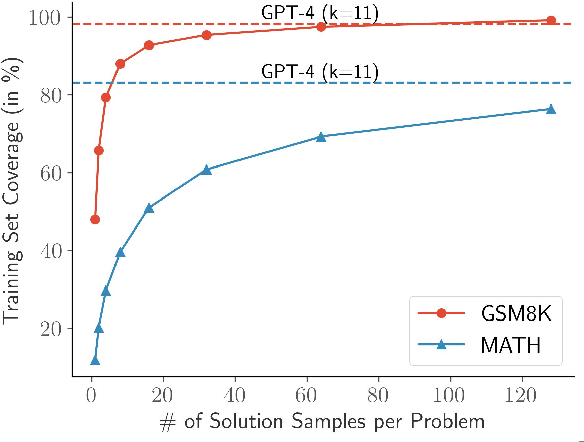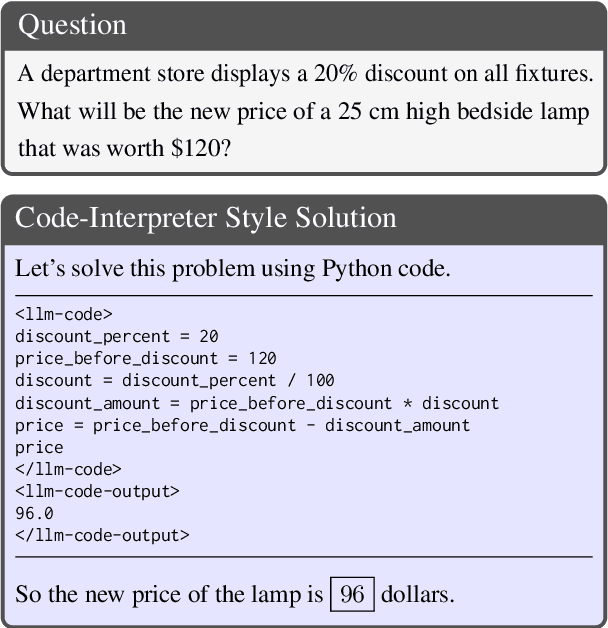Igor Gitman
NVIDIA Nemotron Nano 2: An Accurate and Efficient Hybrid Mamba-Transformer Reasoning Model
Aug 21, 2025



Abstract:We introduce Nemotron-Nano-9B-v2, a hybrid Mamba-Transformer language model designed to increase throughput for reasoning workloads while achieving state-of-the-art accuracy compared to similarly-sized models. Nemotron-Nano-9B-v2 builds on the Nemotron-H architecture, in which the majority of the self-attention layers in the common Transformer architecture are replaced with Mamba-2 layers, to achieve improved inference speed when generating the long thinking traces needed for reasoning. We create Nemotron-Nano-9B-v2 by first pre-training a 12-billion-parameter model (Nemotron-Nano-12B-v2-Base) on 20 trillion tokens using an FP8 training recipe. After aligning Nemotron-Nano-12B-v2-Base, we employ the Minitron strategy to compress and distill the model with the goal of enabling inference on up to 128k tokens on a single NVIDIA A10G GPU (22GiB of memory, bfloat16 precision). Compared to existing similarly-sized models (e.g., Qwen3-8B), we show that Nemotron-Nano-9B-v2 achieves on-par or better accuracy on reasoning benchmarks while achieving up to 6x higher inference throughput in reasoning settings like 8k input and 16k output tokens. We are releasing Nemotron-Nano-9B-v2, Nemotron-Nano12B-v2-Base, and Nemotron-Nano-9B-v2-Base checkpoints along with the majority of our pre- and post-training datasets on Hugging Face.
GenSelect: A Generative Approach to Best-of-N
Jul 23, 2025Abstract:Generative reward models with parallel sampling have enabled effective test-time scaling for reasoning tasks. Current approaches employ pointwise scoring of individual solutions or pairwise comparisons. However, pointwise methods underutilize LLMs' comparative abilities, while pairwise methods scale inefficiently with larger sampling budgets. We introduce GenSelect, where the LLM uses long reasoning to select the best solution among N candidates. This leverages LLMs' comparative strengths while scaling efficiently across parallel sampling budgets. For math reasoning, we demonstrate that reasoning models, such as QwQ and DeepSeek-R1-0528, excel at GenSelect, outperforming existing scoring approaches with simple prompting.
Llama-Nemotron: Efficient Reasoning Models
May 02, 2025Abstract:We introduce the Llama-Nemotron series of models, an open family of heterogeneous reasoning models that deliver exceptional reasoning capabilities, inference efficiency, and an open license for enterprise use. The family comes in three sizes -- Nano (8B), Super (49B), and Ultra (253B) -- and performs competitively with state-of-the-art reasoning models such as DeepSeek-R1 while offering superior inference throughput and memory efficiency. In this report, we discuss the training procedure for these models, which entails using neural architecture search from Llama 3 models for accelerated inference, knowledge distillation, and continued pretraining, followed by a reasoning-focused post-training stage consisting of two main parts: supervised fine-tuning and large scale reinforcement learning. Llama-Nemotron models are the first open-source models to support a dynamic reasoning toggle, allowing users to switch between standard chat and reasoning modes during inference. To further support open research and facilitate model development, we provide the following resources: 1. We release the Llama-Nemotron reasoning models -- LN-Nano, LN-Super, and LN-Ultra -- under the commercially permissive NVIDIA Open Model License Agreement. 2. We release the complete post-training dataset: Llama-Nemotron-Post-Training-Dataset. 3. We also release our training codebases: NeMo, NeMo-Aligner, and Megatron-LM.
NeMo-Inspector: A Visualization Tool for LLM Generation Analysis
May 01, 2025Abstract:Adapting Large Language Models (LLMs) to novel tasks and enhancing their overall capabilities often requires large, high-quality training datasets. Synthetic data, generated at scale, serves a valuable alternative when real-world data is scarce or difficult to obtain. However, ensuring the quality of synthetic datasets is challenging, as developers must manually inspect and refine numerous samples to identify errors and areas for improvement. This process is time-consuming and requires specialized tools. We introduce NeMo-Inspector, an open-source tool designed to simplify the analysis of synthetic datasets with integrated inference capabilities. We demonstrate its effectiveness through two real-world cases. Analysis and cleaning of the synthetically generated GSM-Plus dataset with NeMo-Inspector led to a significant decrease in low-quality samples from 46.99% to 19.51%. The tool also helped identify and correct generation errors in OpenMath models, improving accuracy by 1.92% on the MATH dataset and by 4.17% on the GSM8K dataset for a Meta-Llama-3-8B model fine-tuned on synthetic data generated from Nemotron-4-340B.
AIMO-2 Winning Solution: Building State-of-the-Art Mathematical Reasoning Models with OpenMathReasoning dataset
Apr 23, 2025Abstract:This paper presents our winning submission to the AI Mathematical Olympiad - Progress Prize 2 (AIMO-2) competition. Our recipe for building state-of-the-art mathematical reasoning models relies on three key pillars. First, we create a large-scale dataset comprising 540K unique high-quality math problems, including olympiad-level problems, and their 3.2M long-reasoning solutions. Second, we develop a novel method to integrate code execution with long reasoning models through iterative training, generation, and quality filtering, resulting in 1.7M high-quality Tool-Integrated Reasoning solutions. Third, we create a pipeline to train models to select the most promising solution from many candidates. We show that such generative solution selection (GenSelect) can significantly improve upon majority voting baseline. Combining these ideas, we train a series of models that achieve state-of-the-art results on mathematical reasoning benchmarks. To facilitate further research, we release our code, models, and the complete OpenMathReasoning dataset under a commercially permissive license.
Nemotron-H: A Family of Accurate and Efficient Hybrid Mamba-Transformer Models
Apr 10, 2025Abstract:As inference-time scaling becomes critical for enhanced reasoning capabilities, it is increasingly becoming important to build models that are efficient to infer. We introduce Nemotron-H, a family of 8B and 56B/47B hybrid Mamba-Transformer models designed to reduce inference cost for a given accuracy level. To achieve this goal, we replace the majority of self-attention layers in the common Transformer model architecture with Mamba layers that perform constant computation and require constant memory per generated token. We show that Nemotron-H models offer either better or on-par accuracy compared to other similarly-sized state-of-the-art open-sourced Transformer models (e.g., Qwen-2.5-7B/72B and Llama-3.1-8B/70B), while being up to 3$\times$ faster at inference. To further increase inference speed and reduce the memory required at inference time, we created Nemotron-H-47B-Base from the 56B model using a new compression via pruning and distillation technique called MiniPuzzle. Nemotron-H-47B-Base achieves similar accuracy to the 56B model, but is 20% faster to infer. In addition, we introduce an FP8-based training recipe and show that it can achieve on par results with BF16-based training. This recipe is used to train the 56B model. All Nemotron-H models will be released, with support in Hugging Face, NeMo, and Megatron-LM.
OpenMathInstruct-2: Accelerating AI for Math with Massive Open-Source Instruction Data
Oct 02, 2024Abstract:Mathematical reasoning continues to be a critical challenge in large language model (LLM) development with significant interest. However, most of the cutting-edge progress in mathematical reasoning with LLMs has become \emph{closed-source} due to lack of access to training data. This lack of data access limits researchers from understanding the impact of different choices for synthesizing and utilizing the data. With the goal of creating a high-quality finetuning (SFT) dataset for math reasoning, we conduct careful ablation experiments on data synthesis using the recently released \texttt{Llama3.1} family of models. Our experiments show that: (a) solution format matters, with excessively verbose solutions proving detrimental to SFT performance, (b) data generated by a strong teacher outperforms \emph{on-policy} data generated by a weak student model, (c) SFT is robust to low-quality solutions, allowing for imprecise data filtering, and (d) question diversity is crucial for achieving data scaling gains. Based on these insights, we create the OpenMathInstruct-2 dataset, which consists of 14M question-solution pairs ($\approx$ 600K unique questions), making it nearly eight times larger than the previous largest open-source math reasoning dataset. Finetuning the \texttt{Llama-3.1-8B-Base} using OpenMathInstruct-2 outperforms \texttt{Llama3.1-8B-Instruct} on MATH by an absolute 15.9\% (51.9\% $\rightarrow$ 67.8\%). Finally, to accelerate the open-source efforts, we release the code, the finetuned models, and the OpenMathInstruct-2 dataset under a commercially permissive license.
Nemotron-4 340B Technical Report
Jun 17, 2024



Abstract:We release the Nemotron-4 340B model family, including Nemotron-4-340B-Base, Nemotron-4-340B-Instruct, and Nemotron-4-340B-Reward. Our models are open access under the NVIDIA Open Model License Agreement, a permissive model license that allows distribution, modification, and use of the models and its outputs. These models perform competitively to open access models on a wide range of evaluation benchmarks, and were sized to fit on a single DGX H100 with 8 GPUs when deployed in FP8 precision. We believe that the community can benefit from these models in various research studies and commercial applications, especially for generating synthetic data to train smaller language models. Notably, over 98% of data used in our model alignment process is synthetically generated, showcasing the effectiveness of these models in generating synthetic data. To further support open research and facilitate model development, we are also open-sourcing the synthetic data generation pipeline used in our model alignment process.
OpenMathInstruct-1: A 1.8 Million Math Instruction Tuning Dataset
Feb 15, 2024



Abstract:Recent work has shown the immense potential of synthetically generated datasets for training large language models (LLMs), especially for acquiring targeted skills. Current large-scale math instruction tuning datasets such as MetaMathQA (Yu et al., 2024) and MAmmoTH (Yue et al., 2024) are constructed using outputs from closed-source LLMs with commercially restrictive licenses. A key reason limiting the use of open-source LLMs in these data generation pipelines has been the wide gap between the mathematical skills of the best closed-source LLMs, such as GPT-4, and the best open-source LLMs. Building on the recent progress in open-source LLMs, our proposed prompting novelty, and some brute-force scaling, we construct OpenMathInstruct-1, a math instruction tuning dataset with 1.8M problem-solution pairs. The dataset is constructed by synthesizing code-interpreter solutions for GSM8K and MATH, two popular math reasoning benchmarks, using the recently released and permissively licensed Mixtral model. Our best model, OpenMath-CodeLlama-70B, trained on a subset of OpenMathInstruct-1, achieves a score of 84.6% on GSM8K and 50.7% on MATH, which is competitive with the best gpt-distilled models. We release our code, models, and the OpenMathInstruct-1 dataset under a commercially permissive license.
Confidence-based Ensembles of End-to-End Speech Recognition Models
Jun 27, 2023Abstract:The number of end-to-end speech recognition models grows every year. These models are often adapted to new domains or languages resulting in a proliferation of expert systems that achieve great results on target data, while generally showing inferior performance outside of their domain of expertise. We explore combination of such experts via confidence-based ensembles: ensembles of models where only the output of the most-confident model is used. We assume that models' target data is not available except for a small validation set. We demonstrate effectiveness of our approach with two applications. First, we show that a confidence-based ensemble of 5 monolingual models outperforms a system where model selection is performed via a dedicated language identification block. Second, we demonstrate that it is possible to combine base and adapted models to achieve strong results on both original and target data. We validate all our results on multiple datasets and model architectures.
 Add to Chrome
Add to Chrome Add to Firefox
Add to Firefox Add to Edge
Add to Edge